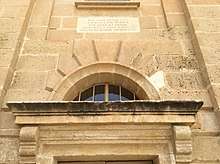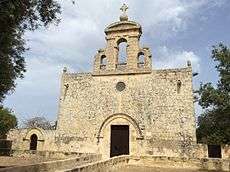Gudja
| Gudja Il-Gudja | |||
|---|---|---|---|
| Local council | |||
 Parish Church of the Assumption | |||
| |||
|
Motto(s): Pluribus parens (Mother of many children) | |||
 | |||
| Coordinates: 35°50′54″N 14°30′9″E / 35.84833°N 14.50250°ECoordinates: 35°50′54″N 14°30′9″E / 35.84833°N 14.50250°E | |||
| Country |
| ||
| Region | Southern Region | ||
| District | South Eastern District | ||
| Borders | Għaxaq, Luqa, Santa Luċija | ||
| Government | |||
| • Mayor | John Mary Calleja (PL) | ||
| Area | |||
| • Total | 2.3 km2 (0.9 sq mi) | ||
| Population (March 2014) | |||
| • Total | 2,997 | ||
| • Density | 1,300/km2 (3,400/sq mi) | ||
| Demonym(s) | Gudjan (m), Gudjana (f), Gudjani (pl) | ||
| Time zone | UTC+1 (CET) | ||
| • Summer (DST) | UTC+2 (CEST) | ||
| Postal code | GDJ | ||
| Dialing code | 356 | ||
| ISO 3166 code | MT-11 | ||
| Patron saints | Assumption of Mary; Our Lady of Rosary; Our Lady of Consolation | ||
| Day of festa | 15 August; 1st Sunday of October; last Sunday of October | ||
Gudja is a village in the Southern Region of Malta, with a population of 2,997 as of March 2013.[1] The village is located on high grounds, south of Valletta. It is administered by the Gudja Local Council. A number of schools, clubs, public gardens and recreations places are found around the village. The Malta International Airport is located here.
The area has been inhabited since pre-historic times, evident from remains still in situ. Scarce Punic remains were found in an area known as Xlejli, within the villge. Several remains of the Roman period are scattered in the whereabouts, notoriously the Ħal Resqun Catacombs. The area was inhabited during the Arab and subsequent medieval periods, and the settling found today dates to the Order of St. John. The centre of the village further developed during the British period, after which a number of modern neighbourhoods were built.
The village has a concentration of churches, some dating to the mediaval period, and other secular historic buildings such as Palazzo Dorell. Prominent buildings are now scheduled as Grade 1 or 2. Some buildings and a number of niches and statues are listed on the National Inventory of the Cultural Property of the Maltese Islands.
Name and motto
Gudja means a land located on a higher ground but not a hill, with an approximately round peripheries.[2]
Gudja's coat of arms bears the motto "pluribus parens", which means "Mother of many children". These children are Safi, Kirkop, Ħal-Farruġ, Luqa, Mqabba, Birżebbuġa and Tarxien, which at one time were all part of the parish church of Gudja. From Tarxien then, another three parishes emerged: Fgura, Santa Luċija and the Christ the King Parish of Paola. Then again, from the latter, another parish emerged: the Our Lady of Lourdes parish at Paola.
History
Gudja was inhabited since pre-history, as evidenced by Ta’ Għewra dolmen.[3] Other pre-historic remains are found in Gudja, such as those at the entrance close to the Malta International Airport.[4]
Roman period remains are spread around Gudja, and the most prominent site, of this period, is the Ħal Resqun Catacombs.[5]

The oldest, still in use, houses in Gudja date to at least 1533. A house built by this date is located in the whereabouts close to the main square.[6] A Gothic inscription, with Sicilian influence and Greek letters, sheds history on this residence. Though the words in relief are largely unreadable, there are old photographs and documentation on the considerably unusual inscription.[7]
An unusual tower dating to 1780 was built on the spot of a possible Punic-Roman tower, in an area known as Xlejli. A palace, known as Palazzo Dorell, was built nearby and its garden has enclosed the tower within its grounds. The palace served as the headquarters for British forces under General Graham during the French blockade of 1798–1800.[8]

The Baroque parish church is dedicated to the Assumption of the Virgin Mary, and it is the only one in Malta with three bell towers.[9] The most conspicuous of these is the non-symmetric Neoclassical William Baker Tower.[10]
The interior of the church is decorated with objets d'art. The titular painting is that of the Assumption of the Virgin, painted by Italian artist Pietro Gagliardi in 1887. The same painter was commissioned for the Our Lady of Mount Carmel painting in 1889. Another notable painting is The Death of Saint Joseph, by Italian artist Domenico Bruschi in 1894. The most important sculpture, inside the church, is the titular statue of the Assumption of Our Lady, sculpted out of solid wood, in 1807, by the Maltese Vincenzo Dimech. It is the oldest statue in the Maltese Islands featuring the Assumption of Our Lady

Gudja is known for its 15th century Chapel of Bir Miftuħ. Bir Miftuh was already established as a parish by 1436, making it one of the first parishes on the Maltese Islands.[11][12]
The Chapel of the Madonna of Loreto was built in 1548 by Knight Imbert de Morine as thanksgiving for his safe keeping during a Turkish battle which took place in the area. It was probably built on the same grounds where an older chapel stood.[13]
The Chapel of St Catherine, found at Raymond Caruana street, is an Early Modern church on the site of an earlier chapel.
The Chapel of the Annunciation dates to 1754. According to the pastoral visit of Bishop Bartolomeo Rull, the chapel was built on the design of a Greek cross plan and with a dome. The facade is plain with strategically placed architectural feats. Flanking either side of the facade, there are two flat austere looking Doric pilasters which are topped by a blank entablature. The main portal is surrounded with a stone moulding with emphasis on the two corners above the door. Above the door is a triangular pediment with a arch embedded within. Piercing the facade, there is a window executed in the Baroque style. This window and a square belfry on top were added by sculpture and mason Anglu Dalli on the design of Carlo Farrugia. At the corners of the facade are two statues representing St Anne and Sr Joachim while on the belfry there is a figure of archangel Gabriel. These are the work of Antonio Zammit.[14]
The architect Girolamo Cassar, who is known for designing many buildings in Valletta, was possibly born in Gudja (although some sources state that he was from Birgu).[15]
Pop singer Madonna shortly resided in Gudja, during a visit to the island.[9]
Schools in Gudja
- St Benedict's College, Gudja Primary School, St. Mark Street
- St. Joan Antide School, Filippu Castagna Street
Zones in Gudja
- Bir Miftuħ (Open Well)
- Ta' Loretu (Loreto's Village)
- Ta' Xlejli
- Tal-Ħamra (Reddish Village)
- Tal-Lampat
- Tal-Lebbien
- Tal-Millieri
- Tal-Mitħna (Mill's Village)
- Tat-Tajjara (Cotton's Village)
Gudja Main Roads
- Dawret il-Gudja (Gudja By-Pass)
- Triq Bir Miftuħ (Bir Miftuh Road)
- Triq Ħal-Far (Hal Far Road)
- Triq Ħal-Tarxien (Tarxien Road)
- Triq il-Kbira (Main Street)
- Triq iż-Żebbuġa (Olive Street)
- Triq Raymond Caruana (Raymond Caruana Street)
- Vjal l-Avjazzjoni (Aviation Avenue)
- Triq Ħal-Ghaxaq (Ghaxaq Road)
Organisations
Musical Groups
- Soċjeta Filarmonika La Stella
- Ghaqda Muzikali Marija Assunta
Football
Gudja's football team is known as Gudja United F.C.. The club enjoyed a successful period in the 1980s and in the 2014-2015 season when they narrowly lost promotion to the Premier Division. They have been promoted to the 1st Division in the 2017/2018 season.
Government
The local authority responsible for Gudja and its constituents is the Gudja Local Council, which is made up of five democratically-elected Councillors. The first Local Council elections in Gudja took place in 1994 after the Local Councils Act was approved in Parliament in 1993. Since then, a further six elections took place - in 1997, 2000, 2003, 2006, 2009 and 2013. For the first few years, Local Councils served for a mandate of three years while for the 2009 - 2013 term, the mandate was increased to four years. The current Local Council is expected to serve till 2019, due to changes in the Act itself, which extended the term served to five years to coincide with the European Parliament elections, which also take place every five years.
References
- ↑ "Estimated Population by Locality 31st March, 2014". Government of Malta. 16 May 2014. Archived from the original on 21 June 2015.
- ↑ Caruana, Joseph (2011). "Toponomi t'Għajnsielem (1)" (PDF). L-Imnara. Rivista tal-Għaqda Maltija tal-Folklor. 9 (4): 188. Archived from the original (PDF) on 18 April 2016.
- ↑ Sagona, Claudia (2015). The Archaeology of Malta. Cambridge University Press. p. 317. ISBN 9781107006690.
- ↑ https://www.gov.mt/en/Government/Documents/PA%20Listings%20Notices/1996/gn35_96.pdf
- ↑ Sagona, Claudia (2015). The Archaeology of Malta. Cambridge University Press. p. 311. ISBN 9781107006690.
- ↑ "Rahal tal-Gudja". Is-Socjetà Filarmonika La Stella. Archived from the original on 5 December 2016.
- ↑ Brincat, Joseph M. (1991). "An inscription (1533) and a letter (1798)". Melita Historica. 10 (4): 353–358. Archived from the original on 21 April 2014.
- ↑ "Palazzo Dorell" (PDF). National Inventory of the Cultural Property of the Maltese Islands. 28 December 2012. Retrieved 5 June 2015.
- 1 2 "Gudja". malta.com. Archived from the original on 17 May 2017.
- ↑ A.P.G. Lib. Calcoli e Notizie Diverse 1862;L.N.M. ‘L’Ordine’ Giornale Politico-Religioso, venerdi 19 aprile 1861.
- ↑ "Chapel of Santa Marija ta’ Bir Miftuh", Din l-Art Ħelwa, Malta, 10 October 2011. Retrieved on 29 January 2015.
- ↑ Grech, Alex. "A medieval gem: Bir Miftuh Chapel", Malta inside out, Malta. Retrieved on 29 January 2015.
- ↑ National Inventory of the Cultural property in Malta
- ↑ National Inventory of the Cultural property in Malta
- ↑ Schiavone, Michael J. (2009). Dictionary of Maltese Biographies Vol. 1 A-F. Pietà: Pubblikazzjonijiet Indipendenza. p. 520. ISBN 9789993291329.
External links
| Wikimedia Commons has media related to Gudja. |

